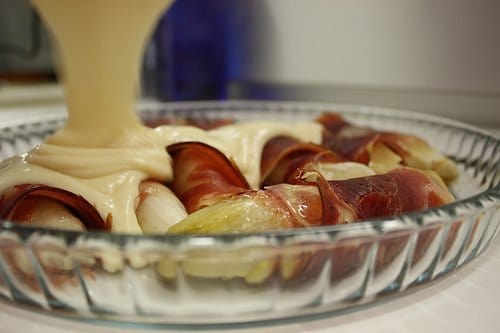White sauce, also known as bechamel sauce, is a versatile sauce made from butter, flour, and milk. It is commonly used as a base for many dishes, including pasta, lasagna, and casseroles.
But what if you’re left with a cup of bechamel after cooking that mac and cheese or lasagna? Can you freeze white sauce for later use?
The good news is that you can freeze bechamel sauce, and it can last in the freezer for up to 6 months. That saves you time in the future and reduces food waste, which is a win in my books.
That said, there are a few things you should keep in mind when freezing white sauce to ensure that it maintains its quality and flavor.

How to Freeze White Sauce
Here are the steps to freeze bechamel sauce:
- Cool down. Before freezing, make sure the white sauce is completely cool. This will prevent condensation from forming and freezer burn from setting in right away.
- Portion. Portion the sauce into smaller quantities so that you can thaw only what you need.
- Package. There are a few ways to package bechamel sauce for freezing:
- Freezer bags: Portion the white sauce into bags, remove as much air as possible from each ziploc bag, and seal tightly.
- Airtight containers: Use freezer-safe containers made for freezing, leaving some headspace to allow for expansion during freezing.
- Ice cube trays: Pour the white sauce into ice cube trays and flash freeze them. Once frozen solid, pop out the cubes and transfer them to a freezer bag and back to the freezer.
- Label. Label each package with the date and contents before storing it in the freezer. Frozen bechamel sauce doesn’t look like much, so labeling it will come in handy when you need to identify it in a few weeks.
Frozen this way, white sauce should retain good quality for about 6 months in the freezer but will stay safe to use indefinitely.
You can use the same technique when freezing nacho cheese sauce or alfredo sauce.
Next up, let’s talk about thawing bechamel sauce.

Thawing White Sauce
Thawing white sauce properly is important to ensure that it retains its texture and flavor. Here are some methods you can use to thaw white sauce:
Refrigerator Method
This is the safest and most recommended method to defrost white sauce.
Simply transfer the frozen white sauce from the freezer to the refrigerator and let it thaw overnight. This method will ensure that the sauce thaws evenly and safely.
Cold Water
If you’re in a hurry, you can thaw white sauce by placing the frozen container in a bowl of cold water. Make sure the container is sealed tightly and submerge it in the water. Change the water every 30 minutes until the sauce is defrosted. This method is faster than the refrigerator method, but it’s not as safe. To make it much safer, place the bowl of cold water in the fridge. It won’t defrost as quickly as if left at room temperature, but it’ll still be much quicker than if you simply left it in the fridge overnight.
On the Stovetop
Pour a bit of milk or water into a pot or nonstick skillet and add in the frozen bechamel. Put that pot or skillet over low heat and slowly defrost, stirring constantly. If you notice things get too warm and the sauce is about to burn, take the pot off the heat for 15 to 30 seconds so that it cools down.
This method works okay-ish but can be tricky not to burn the sauce, so use it only if you’re in a hurry and forgot to thaw the sauce overnight.
Microwave
I wouldn’t recommend thawing frozen white sauce in a microwave. Sure, that could be done using the defrost setting and stirring the sauce every 30 seconds or so, but it’s too easy to overcook the exterior while the inside of your bechamel is still frozen.
Can You Refreeze White Sauce?
Yes, as long as you’ve defrosted it in the fridge or cooked it through before placing back in the freezer. Keep in mind that refreezing degrades the quality of the sauce even further, so you probably don’t want to do that unless you have to.
Instead, try to find a way to use whatever you have after defrosting. I give you a couple of ideas later in the article.
Reheating White Sauce
White sauce can be reheated in a variety of ways, depending on your preference and the amount of time you have. Here are a few methods:
- Stovetop: Place the white sauce in a saucepan and heat over medium-low heat and stir frequently until heated through. Be careful not to let the sauce boil or scorch.
- Microwave: Transfer the white sauce to a microwave-safe bowl and heat on medium in 30-second intervals, stirring in between, until heated through. This method has the same downsides as defrosting in the microwave, so it’s probably best if you choose a different option.
- Use in a dish: Adding the defrosted sauce to mac and cheese or a casserole is probably the easiest option out there. You stir in the bechamel and cook the dish as you normally would.
Keep in mind that the sauce thickens when you reheat it, so you might need to thin it out with a little milk or cream. Also, stir it frequently to prevent a skin from forming on the top.
Next, make sure you heat the sauce thoroughly before serving to make sure it’s perfectly safe for consumption.
Finally, it’s important to note that reheated white sauce may have a slightly different texture than a freshly made one. It may be slightly grainy and will likely be thicker if you don’t add extra milk or cream. Those slight changes are expected and don’t affect the taste that much.
That said, defrosted bechamel sauce works well in some dishes and not nearly as well in others. Let’s cover that.
Using Defrosted White Sauce: What to Try and What to Avoid
Defrosted white sauce can be used in a variety of dishes, but it is important to note that the texture and consistency of the sauce may change slightly after it has been frozen and thawed.
Here are a few dishes where defrosted white sauce works best:
- Pasta dishes: Defrosted white sauce can be a great addition to pasta dishes such as fettuccine alfredo, macaroni and cheese, and lasagna.
- Casseroles: White sauce can add flavor and creaminess to casseroles such as chicken and broccoli casserole or tuna casserole.
- Pot pies: Defrosted white sauce can be used as a filling for pot pies, adding a creamy texture to the dish.
You can also venture a bit more into French cuisine and make one of the child sauces of bechamel, such as Mornay sauce (basically turning white sauce into cheese sauce), Nantua, Soubise, or any other.
Defrosted white sauce may not work as well in dishes where the texture of the sauce is crucial, such as in soufflés, or if you use it as a pour-on sauce.